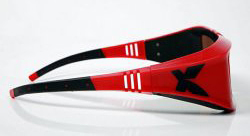Possible Catch-22: Incompatible 3D Glasses

Things seemed to have been going a bit too smoothly for 3D proponents this year, so it was only a matter of time before some possible hurdle appeared. And not unlike most other emerging technical innovations, that hurdle right now seems to be "incompatibility."
Fortunately, we're only talking about the glasses, not the far, far more expensive 3D HD sets themselves.
According to industry analyst DisplaySearch, one of the hot topics at its recent conference was "the issue of interoperability of active-shutter 3D glasses between [3D HD] sets made by different brands." (This only applies to 3D on TV, not in theaters.) DisplaySearch said various 3D TV set makers have all been fairly quiet about the issue of incompatible glasses at home, aside from quietly wishing among themselves that there was some cross-compatibility.
The analyst said any incompatibility of glasses between 3D brands could be a problem for consumers on a very real-world level — such as inviting visitors over to watch the World Cup later this spring in 3D, only to find the guests' glasses won't work with the host's 3D system. (This scenario presumes we'll each have our own pair of personal shutter glasses sooner or later.) New 3D sets coming to market typically come with only one or two pairs of glasses, which are not cheap.
Yet a solution to this lack of technical interoperability may already be in the works, according to By Paul Gagnon, DisplaySearch's director of North American TV research. DisplaySearch said a handful of "third-party" shutter-glass manufacturers already seem to be taking advantage of this looming dilemma and may be getting close to introducing their own forms of "universal" glasses. One firm, XpanD, is making glasses that are compatible with some, but not all, 3D systems.
Get the TV Tech Newsletter
The professional video industry's #1 source for news, trends and product and tech information. Sign up below.
